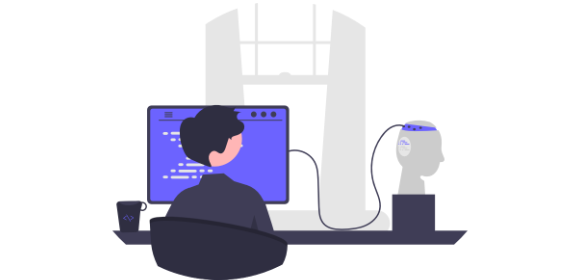What is AI Transcription? Everything You Need to Know

Everything You Need to Know About AI Transcription
It may make it sound like science fiction, but artificial intelligence is already woven into our daily lives. It's a fact. Every time you open a social media app, it's artificial intelligence that personalizes what you see on your feeds. Each time you say "Hey Siri" or "Alexa", it's AI that understands what you're asking and responds to your request.
AI transcription is yet another example of how artificial intelligence is used in everyday life - simplifying those laborious tasks we once did manually. But what exactly is AI transcription? Where did it come from, how is it used today, and where might it be headed in the future?
Let's answer some of your burning questions...
What is AI transcription?
AI transcription is the use of artificial intelligence to convert speech into text. Instead of a human having to physically take notes or transcribe an audio recording, AI transcription does the work for you, listening to your audio and translating it into text.
The benefits of AI transcription - also referred to as speech recognition or automatic speech recognition - are clear and tangible. It's incredibly fast - the power of AI means you can get a transcript in minutes, if not seconds, compared to the hours it would take to transcribe manually.
AI transcription is also far more affordable than human transcription services. That's because an hour of audio takes approximately four hours for a professional to transcribe, at an average rate of 75 cents to $1.50 per minute. That works out as $45-$90 per hour of audio transcription. By comparison, an hour of transcription time costs as little as $2 with Transcribe, making it an accessible solution for projects on any budget.
How does speech recognition work?
Things could get really technical here, so we'll keep it as straightforward as possible.
Think about how a child learns a language. They hear speech around them on a daily basis, which trains their brain to build connections between sounds, words, and their meaning.
Speech recognition technology works in a very similar way. Advanced machine learning and natural language processing techniques train computers to recognize sounds and build connections between those very same sounds, words, and their meaning.
The software listens to speech and compares what it hears to what's stored in its extensive library of words, expressions, and sentences so that it can convert what it hears into text.
And there you have it - an AI transcript!
AI transcription: a brief history
AI transcription isn't something that was born overnight - it's something that scientists have been working on for decades. Let's take a look at the brief history of speech recognition.
1952 - The first ever speech recognition system - named Audrey - was built by Bell Laboratories. It could recognize the sound of a spoken digit (zero to nine) with more than 90% accuracy when spoken by its developer, but it was far less accurate with voices it wasn't familiar with.
1960s - At the 1962 World Fair, IBM showcased the Shoebox, which could understand 16 spoken English words. In the same decade, the Soviets created an algorithm capable of recognizing 200 words. All these were based on individual words being matched against stored voice patterns.
1970s - A program at Carnegie Mellon University, funded by the US Department of Defense, developed the Harpy, which had a vocabulary of over 1,000 words. The biggest breakthrough was that it could recognize entire sentences.
1980s - IBM created a voice-activated typewriter called Tangora, which had a 20,000-word vocabulary and used statistics to predict and identify words.
1990s - At the very start of the decade, Dragon Systems released the first consumer speech recognition product - the Dragon Dictate. In 1997, they released an upgrade called Dragon NaturallySpeaking. This was the first continuous speech recognition product, and it could recognise speech at 100 words per minute. Fun fact: it's still used today!
2000s onwards - From the 2000s onward, AI speech-to-text technology has advanced at an astonishing pace. Google led the way with its voice search product, and Apple, Amazon, and Microsoft quickly followed suit with Siri, Alexa, and Cortana.
Present day - Today, AI transcription tools are more sophisticated and widely available than ever. They're not only capable of converting speech to text but can also recognize different accents, dialects, and languages with improved accuracy. Thanks to advanced natural language processing, many AI transcription tools can even summarize transcripts and handle multilingual content.
How is AI transcription used today?
AI transcription is used in a whole host of ways today. From dictating messages to your friends and family to asking Siri to perform a Google search for you, chances are you're already benefiting from AI transcription in one way or another.
With accuracy levels continually improving, AI transcription has become a go-to solution for everything from creating meeting notes to interview transcripts, making it an invaluable tool across various industries and everyday use cases:
-
Businesses use it to create written records of meetings, conferences, and Zoom calls, making information easily accessible and shareable.
-
Academics use it to generate lecture notes for students, and to transcribe academic interviews conducted for research projects, streamlining data collection.
-
Students use it to save themselves the trouble of note-taking during lectures and seminars, receiving written lecture transcripts within minutes of class ending to aid their studies and revision.
-
Podcasters use it to produce podcast transcripts to publish alongside their episodes, enhancing their accessibility and searchability.
-
Journalists use it for interview and press conference notes, and to add captions to video interviews, improving reach and engagement.
Trends and the future of AI transcription
Let's dive into some key data and trends shaping the future of AI transcription.
According to Statista, e-learning and market research are currently the top industries using AI transcription, with a 64% usage rate. This is closely followed by the software and internet industry, along with advertising and marketing, where AI transcription is becoming essential for fast, efficient content creation.
The global voice recognition market is projected to grow from $10.7 billion in 2020 to $27.16 billion by 2026, and AI transcription will inevitably benefit from this growth. With increasing investments, we can expect faster, more accurate, and widely accessible transcription tools, making AI transcription a preferred choice over traditional human transcription services and DIY transcription methods.
As AI software continues to advance, transcription tools are becoming adept at recognizing a wider range of accents and distinguishing between multiple speakers, even in complex audio settings. Current innovations already allow for topic analysis and automated summarization, but the future promises even more refined and nuanced features, such as real-time sentiment analysis and customizable summaries tailored to different use cases.
Ultimately, AI transcription will continue to transform how businesses and individuals handle audio content, making meetings more productive, increasing workplace efficiency, and allowing for quick, affordable, and highly accurate conversion of speech to text.
Want to see how AI transcription can benefit you today?
Download the Transcribe app or launch the online editor to get started.

Human vs AI Transcription Services: Which is Right for You?
Find out the key differences between human and automatic transcription services, the advantages and disadvantages of each, and how to choose between the two.